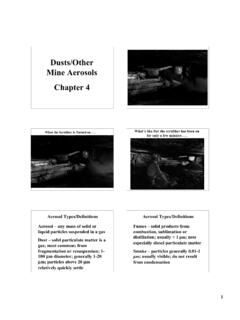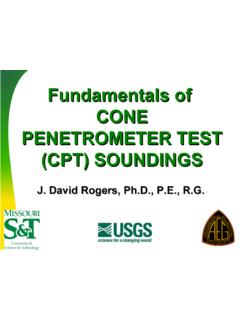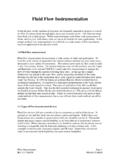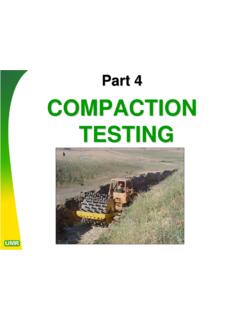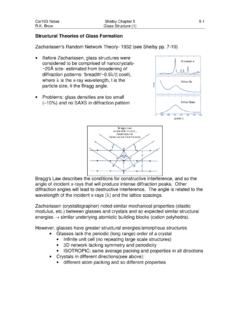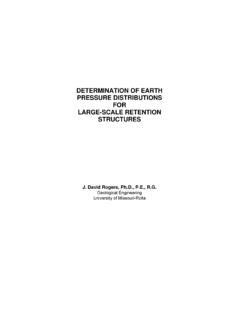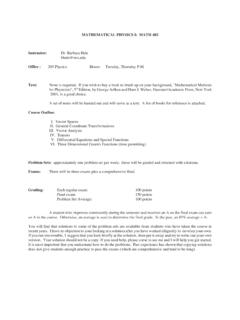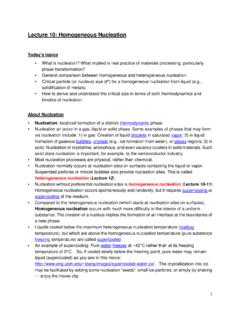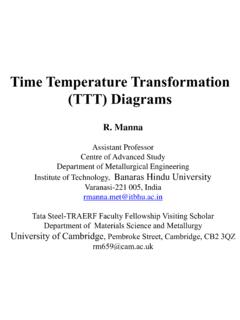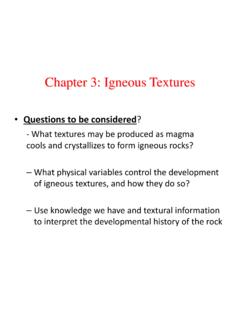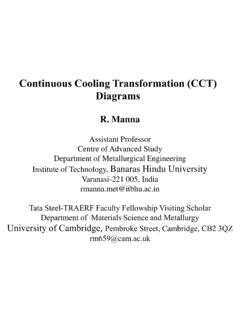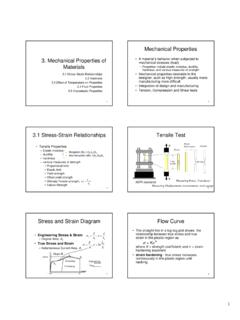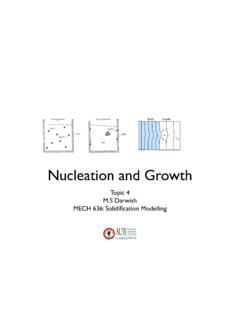Transcription of Nucleation and Growth
1 1WS20021 Nucleation and Growth GoalUnderstand the basic thermodynamics behind the nucleationand Growth processes ReferencesHandoutCh. 8, Intro. to Ceramics by Kingery, Bowen and UhlmannMost books on glasses and glass-ceramics HomeworkNone2WS20022 Phase Transformations Considered as a transformation of a homogeneous solution to a mixtureof two phases For a stable solution, Gmix is less than zero. In other words, the solutionis more stable than the individual components Gmix is composed of entropic (-T Smix) and enthalpic ( Hmix) parts Consider1. Hmix less than zero: stable solution2. Hmix = zero (ideal solution), stable solution due to entropic 3. Hmix slightly greater than zero: stable solution entropy dominates4.
2 Hmix >> 0: enthalpy dominates, phase separation occurs Note: in all cases as T increases, entropy becomes more important, so atvery high temperatures , solutions are usually favored3WS20023 Phase separation If Hmix is greater than zero, the overall Gmix can be greater thanzero meaning that phase separation is favored As T increases, homogeneous solution is favored Tc, the consulate temperature is the point above which solution isfavored Behavior described by a series of G vs. composition curves atdifferent temperaturesInflection points and minima plotted on T vs. comp. Diagram Spinodals from inflection points4WS20024 Spinodal Decomposition A continuous phase transformationInitially, small composition changes that are wide-rangingGive interpenetrating microstructure (2 continuous phases) No thermodynamic barrier to phase separationOne phase separates into twoInfinitesimal composition changes lower the system free energy Very important in glass and liquidsVycorLiquid-liquid phase separation5 Nucleation and Growth Important for.
3 Phase transitions, precipitation, crystallization of glassesMany other phenomena Nucleation has thermodynamic barrier Initially, large compositional changeSmall in size Volume transformations to phase transformationAvrami equationV is the volume of second phaseV is system volumeIv is the Nucleation rateu is the Growth ratet is timeSigmoidal transformation curves Infinitesimal changes raise system free energy VVIutv = and growthVolume Fraction TransformedNormalized Time of Reaction6WS20026 Volume Energy Gv is Grxn (energy/volume) times the new phase volume Spherical clusters have the minimum surface area/volume ratio So: the volume term can be: ()volumeGorrGvv 433 7WS20027 Surface Energy The LaPlace equation shows the importance of surface energyWhere: P is the pressure drop across a curved surface is the surface energyr is particle radius Surface energy is important for small particles Nuclei are on the order of 100 molecules More generally, surface energy is given by:Where: A is the surface area of the particle, bubble, etc.
4 Pr=2 = GAT P composition,, Equation/Kelvin Effect P (atm)Radius ( m)8WS20028 Nucleation Consider the Nucleation of a new phase at a temperature TThe transition temperature (T) is below that predicted bythermodynamics when surface or volume are not considered We can estimate the free energy changeas a function of the radius of the nucleifrom the volume and surface terms When r is small, surface dominates When r is large, volume dominates r* is the inflection point = TT T0 Increasing Temperature phase stableToT T phase stable-4 10-13-2 10-130 1002 10-134 10-1302 10-84 10-86 10-88 10-81 10-7 NucleationSurface Term (~x2)Volume Term (~x3)Sum of Surface and Volume G (J)Radius (m)r* G*9WS20029 Nucleation r* is the critical size nucleus and inflection point on the curveAt r*: We can use this to calculate r* and Gr* () =Grr0 rGGGvv**()= = 216332 10WS200210 Critical Nuclei The number of molecules in the critical nucleus, n*, can becalculated by equating the volume of the critical nucleus, 4/3 (r*)3,with the volume of each molecule, V, times the number ofmolecules per nucleus Substituting the previous equations and solving gives 433 (*)*rnV= nVGv*()= 32333 11WS200211 Nucleus Formation The number of nuclei can be calculated using statistical entropyWhere.
5 Gn is the free energy for cluster formationNr is the number of clusters of radius r per unit volumeN is the number of molecules per unit volume At equilibrium, Nr <<N so the previous equation simplifies to: = ++ + ++ + GNGkTNNNNNNNNNNNN nrrrrrrrrlnln NNGkTr**exp= 12WS200212 Nucleation Rate The Nucleation rate, I, is then the product of a thermodynamicbarrier described by Nr* and a kinetic barrier given by the rate ofatomic attachment As the degree of undercooling increases, the thermodynamicdriving force increases, but atomic mobility decreases INGkTNkThGkTSm= expexp*KineticLimitationThermoDrivingFor ceTo T increasingT increasingNucleation Rate T INkThGkTNTTH kTsmorxn= expexp()()1633222 13WS200213 Heterogeneous Nucleation In many cases (some argue all cases)
6 , Nucleation occurs at asurface, interface, impurity, or other heterogeneities in the system The energy required for Nucleation is reduced by a factor related tothe contact angle of the nucleus on the foreign surface = =+ GGffheto*hom*()()(cos )(cos ) 214214WS200214 Growth Compared to Nucleation , Growth is relatively simpleAssume that stable nuclei exist prior to growthAdd molecules to a stable clusterDriven by free energy decrease of phase changeKinetically limitedWhere: u = Growth rate per unit area of interfaceao = distance across the - interface (~ 1 atomic dia.) Gm = activation energy for mobility or diffusion = frequency factorWhere: is atomic mobility of viscosity uaGkTom= 1 exp =kTao3315WS200215 Summary The thermodynamic driving force for both Nucleation and Growth increasesas undercooling increases, but both become limited by atomic mobility As we cool from the reaction temperature To we find 4 regions:Region I, is metastable, no grows since no nuclei have formedRegion II, mixed Nucleation and growthRegion III, Nucleation onlyRegion IV, no Nucleation or Growth due to atomic mobility Implications for tailoring microstructureTo T increasingT increasingI and u Rate TIIIIIIIVG rowthNucleatio

